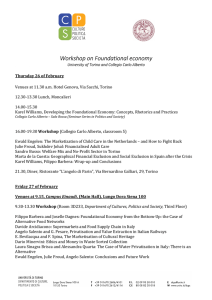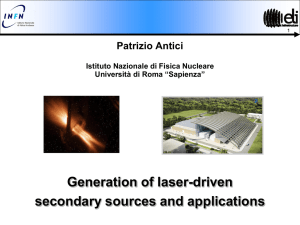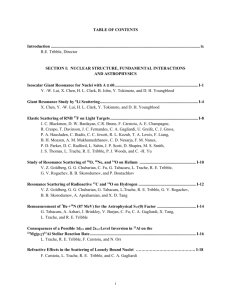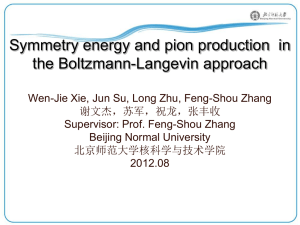Bell inequality for kaons
advertisement
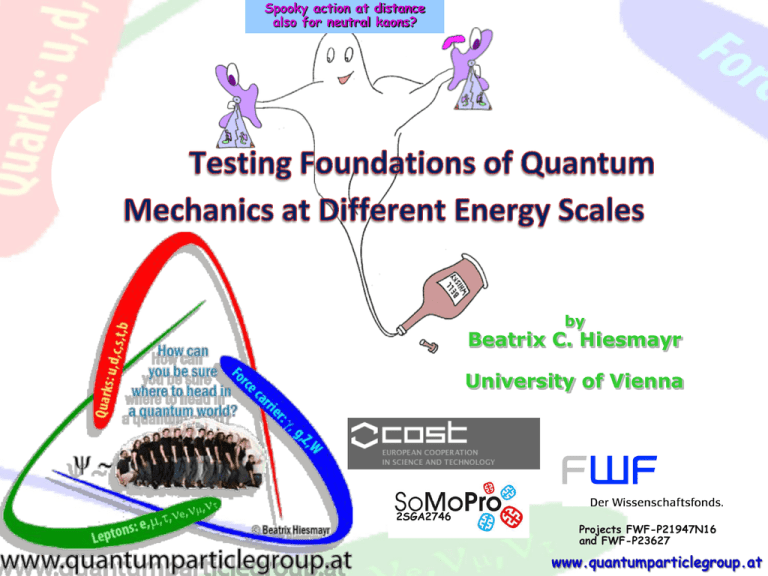
Spooky action at distance
also for neutral kaons?
by
Beatrix C. Hiesmayr
University of Vienna
2SGA2746
Projects FWF-P21947N16
and FWF-P23627
Very short history…
1935: Einstein-Podolsky-Rosen-PARADOX
ALICE
A
ALICE
BOB
a
a
1. pair
2. pair
3. pair
4. pair
…
B
A
Beatrix C. Hiesmayr
B
BOB
The EPR reality criterion: “If without in
any way disturbing a system, one can
predict with certainty (i.e. with the
probability equal to one) the value of a
physical quantity, then there exists an
element of physical reality
corresponding to this physical
quantity.”
Quantum Theory is not complete!
Very short history…
1935: Einstein-Podolsky-Rosen-PARADOX
Hobby:
Foundations of QM
1964: John Stuart Bell
What are Bell inequalities?
No spooky action
at distance!
realism
locality
free will*
*exerting their independence;
totally randomly
Local realistic theories:
Bell’s locality hypothesis
Quantum Mechanics:
P ( a , b) P (a , c ) P ( c , b)
P (a, b) d ( ) pA (a, ) pB (b, )
with
d ( ) 1
inequalities for probabilities
always satisfied!
QM probabilities may
violate the inequalities!
Experiment has to decide!
Are local realistic theories ruled out?
Photons: many experiments, show violations but still
loopholes
Various ordinary matter systems: show violations but
still loopholes
!Single! neutrons: show violations but tests different
aspects
The EPR scenario
1935: Einstein-Podolsky-Rosen-PARADOX
Bell state:
High Energy
Physics
1
2
1
2
H
A
A
K0
12 B 0
...
1
2
V
B
B
A
V
A
B
H
B
... spin 1/2
... photon (polarisation)
K 0 ... kaons (K-mesons)
A
B
B
A
0
0
B-meson
B
B
B 0 ...
A
B
B
A
K
0
K
0
1998: CPLEAR collaboration, Physics Letters B 422, 339
Branching ratio depends
on hydrogen density
1
2
K0
A
K
0
K
B
0
K0
A
B
What are Bell inequalities good for?
• Has been proven: quantum cryptography protocols are save if a
Bell inequality is violated!
• Quantum Computers/Quantum Communication Complexity: Bell
inequalities are necessary and sufficient conditions for quantum
protocols to beat the classical ones!
My goal: to test Bell inequalities for Neutral Kaons
?, H ?, P ?
• very difficult, not straightforwardly (even from theoretical point
of view)!
• but new physics is revealed!
• since last year (2012) there is a hope of a doable experiment
(with KLOE?, with FLAIR?,…?)
Requirements for tests LRT versus QM
Requirements for a conclusive proof of the existence of
correlation stronger than those explainable by
locality and realism/explainable by local resources &
shared randomness:
(1) “Active ” measurements (opening the possibility for
Alice and Bob to choose among alternative setups->
free choice)
(2) “Use all information” (test the whole ensemble;
decay product states are included this “additional”
information cannot be ignored)
are not “only” loopholes!
Bell inequality for kaons
Bertlmann & Hiesmayr,Phys. Rev. A (2001)
0
0
0
0
0
0
0
0
SCHSH ( t a , t b , t c , t d ) : E ( K t a , K t b ) E ( K t a , K t c ) E ( K t d , K t b ) E ( K t a , K t d )
local realistic models
2 S (t n, t m , t n', t m' ; ) 2
0
0
E ( K , ta ; K , t b ) cos m( t a t b ) e ( ta tb )
S Photon 2 2 2.8 Violation!
Kaons?
S Kaon (ta , tb , tc , td ) 2 NO violation!
Summary I
If we believe in QM, then there is “spooky action
at distance” also for this system at different
energy scale, but there exists NO CONCLUSIVE
EXPERIMENT so far.
Hiesmayr, Eur. Phys. J. C (2007)
A violation for observables that can be
actively measured can be found, but for an
initial non-maximally entangled state.
Frascati, Italy
Hiesmayr, Domenico, Curceanu, Gabriel, Huber, Larsson, Moskal, Eur. Phys. J. C (2012)
New Bell inequality for unstable systems that is
experimentally feasible and can be performed with current
technology!
!?Nonlocality related to a symmetry violation?!
Bell inequalities
There exists
correlations
stronger than
classical
physics allows!
CP violation
world
anti-world
CP violation
K0 , K
0
2
,
CP 1
(C…charge conjugations,P…parity)
3
CP 1
Experiment: 1964 Christensen, Cronin, Fitch and Turlay
KS
KL
1
2(1| |2 )
1
2(1| | )
2
{ K1 K 2 }
{ K 2 K1 }
103
CP violation!
Leptonic charge asymmetry:
( K L l l ) ( K L l l )
3
(
3
.
27
0
.
12
)
10
( K L l l ) ( K L l l )
Why are we living in a matter dominated universe?
Bell inequality for kaons
Bertlmann & Hiesmayr,Phys. Rev. A (2001)
0
0
0
0
0
0
0
0
SCHSH ( t a , t b , t c , t d ) : E ( K t a , K t b ) E ( K t a , K t c ) E ( K t d , K t b ) E ( K t a , K t d )
local realistic models
2 S (t n, t m , t n', t m' ; ) 2
taking into account the
decay property without
loosing the conclusiveness
Hiesmayr et al., Eur. Phys. J. C (2012)
min S ( t n , t m , t n', t m ' ; ) S ( t n , t m , t n', t m ' ; ) max S ( t n , t m , t n', t m ' ; )
SEP
SEP
• for stable systems gives +/-2
Bell inequality for kaons
Bell inequality
Bound
min S ( t n , t m , t n', t m ' ; ) S ( t n , t m , t n', t m ' ; ) max S ( t n , t m , t n', t m ' ; )
SEP
SEP
• for stable systems gives +/-2
Bell inequality for kaons
sensitive to CP violation !!!
Bell inequality
Bound
Bell inequality
Bound
B.C. Hiesmayr
Revealing Bell’s Nonlocality for Unstable Systems in High Energy Physics
Hiesmayr, Domenico, Curceanu, Gabriel, Huber, Larsson, Moskal, Eur. Phys. J. C (2012)
Revealing Bell’s Nonlocality for Unstable Systems in High Energy Physics
Hiesmayr, Domenico, Curceanu, Gabriel, Huber, Larsson, Moskal, Eur. Phys. J. C (2012)
A little history…
Drawn by R.A. Bertlmann to the
60th birthday of John Bell
What other foundations of QM can be tested?
… a lot !!
• The kaonic eraser: „Erasing the Past
Impacting the Future“
Bramon, Garbarino, Hiesmayr , Phys. Rev. Lett. 92
Aharanov & Zubairy:
(2004)
Science 307:875, 2005
• Heisenbergs Uncertainty Relation, Bohr‘s
complementarity relation, …
A. Di Domenico, A. Gabriel, B. C. Hiesmayr, F. Hipp, M. Huber, G. Krizek, K.
Mühlbacher, S. Radic, Ch. Spengler and L. Theussl, Found. Of Physics (2011)
A. Bramon, G. Garbarino, Hiesmayr Phys. Rev. A 68 (2004).
• Test entanglement: Is there decoherence in
the system? (->What causes decoherence?
CPT violation (string theory), LorentzInvariance, dark matter,…)
Nature: Scientific
• Collapse Models
Reports:
Testing Collapse Models with
Neutrinos, Mesons and Chiral
Molecules
Summary
Testing Foundations of QM at all energy scales has
started!
Higher energies reveal different aspects and new
physics!
To obtain a full picture of entanglement and to reveal its
role in our universe all systems have to be considered!
Accelerator experiments can add to our understanding of
quantum foundations!
… experiments ? KLOE, ELENA, FLAIR
Thank you for Your attention!
www.quantumparticlegroup.at
Why do we see no macroscopic superpositions?
Is there a border between a quantum and
classical world? And if where is it?
•
SCHRÖDINGER EQUATION:
linear, deterministic, reversible
•
WAVE PACKET REDUCTION
(measurement):
nonlinear, stochastic, irreversible
One solution: COLLAPSE MODELS
(Ghirardi-Rimini-Weber,1986)
Consequence: QM would be not
fundamental assumes a random
field filling space Origin?
Gravitation (Penrose), Dark
matter/energy,…?
Can the collapse be measured for flavor oscillations?
Donaldi, Bassi, Curceanu, DiDomenico, Hiesmayr, arXiv:1207.6000
Bahrami, Donaldi, Ferialdi, Bassi, Curceanu, DiDomenico, Hiesmayr, submitted
K0
1
2
K
S
KL
After a long and cumbersome computation…
P( K 0 , t;| K 0 |) 14 e S t e L t 2 e CSLt cos(mt) e (S L )t
CSL
Can this be measured??
Neutrinos?
strength of the collapse
m
16 rC3 m02
2
3
2
correlation length
This Wednesday and Thursday
Programme of the Workshop „Theory Meets Experiment: Finding Proposals
Towards Testing Foundational Issues in Particle Physics“
8:50-9:00
Wednesday (28.11.2012)
Opening (Hiesmayr); from 8:30 registration
Chairperson: Mavromatos
9:00-9:30
9:30-10:00
10:00-10:30
Possibilities of Foundational Tests with the KLOE Detector:
STATUS&FUTURE (speaker: Di Domenico)
Possibilities of Foundational Tests at the Facility FLAIR:
STATUS&FUTURE (speaker: Grzonka)
Possibilities of Foundational Tests with the Hyperon-Antihyperon
system: STATUS&FUTURE (speaker: Kupsc)
Chairperson: Sponar
11:30-12:00
12:00-12:30
Chairperson:
Brukner
On the Feasibility of Bell's inequality and Other New Foundational
Tests at KLOE-2 (speaker: Di Domenico)
Correlations of Decay Times of Entangled Composite Unstable Systems
(speaker: Durt)
Recent Photon Experiments Testing Local Realism (speaker: Piacentini)
Coffee break
10:30-11:00
11:00-11:30
Thursday (29.11.2012)
Possibilities of Foundational Tests in Atomic, Nuclear and Subnuclear
Systems: STATUS&FUTURE (speaker: Curceanu)
Possibilities of Foundational Tests with Neutrons: STATUS&FUTURE
(speaker: Klepp)
Possibilities of Foundational Tests with Artificially Engineered
Systems: STATUS&FUTURE (speaker: Paraoanu)
12:30-13:00
Lunch Break
Coffee break
Chairperson:
Erker
Optimal inequalities for state-independent contextuality (speaker:
Larsson)
Quantum Frameness for Charge-Parity-Time Reversal Symmetry
(speaker: Skotiniotis)
Simulating Relativistic Effects of Motion with Superconducting Circuits
(speaker: Friis)
Towards Relativistic Quantum Technologies (speaker: Bruschi)
Lunch Break
12:30-15:00
Meeting in Small Groups
CPT in the Early Universe and the Observed Baryon Asymmetry
(speaker: Mavromatos)
Geometrodynamics: the Kaluza-Klein Compactification and the Quantum Meeting in Small Groups
Nonlocality (speaker: De Martini)
Chairperson: Bertlmann
15:00-15:30
15:30-16:00
Coffee Break
16:00-16:30
Chairperson: Larsson
16:30-17:00
Is the Compton Frequency a Particle Identification mark? (speaker:
Rauch)
Coffee Break
Moderated discussions: (Moderator: Curceanu)
Reports from the Small Groups
Closing
An experiment for kaons
How good do these two data
points verify the quantum
mechanical interference term?
Is the Schrödinger-Furry
hypothesis really ruled out?
Is there decoherence in the
0
0
0
0
P
(
K
,
t
;
K
,
t
)
P
(
K
,
t
;
K
, tr )
QM
system? Loss Aof (entanglement?
l
r
l
t )
Traces of quantum gravity, CPT
cos(mt )
violations,…
cosh( 2 t )
Spontaneous factorization of the wave function
Schrödinger-Furry Hypothesis: ( 1)
| |K
Sl
|K
L r
|K
L l
|K
50%
Sr
50%
| K S | K L
l
|K L |K S
r
l
P ( f1 , tl ; f 2 , tr ) 1 2 2 (1 ) Re *1 2
2
Observable:
2
r
0
0
0
P
(
K
,
t
;
K
,
t
)
P
(
K
,
t
;
K
, tr ) cos(mt )
QM
l
r
l
A (tl , tr )
cosh( 2 t )
0
A (t ) A (t ) (1 )
QM
CPLEAR-experiment (1998):
16
0.1300..15
Bertlmann, Grimus and Hiesmayr,
Phys. Rev. D, 60, 114032 (1999)
Spontaneous factorization of the wave function
Schrödinger-Furry Hypothesis ( 1):
| K
0
l
K
0
K
r
l
K0
l
50%
0
|K 0 |K
0
r
50%
0
|K |K 0
l
r
r
P ( f1 , tl ; f 2 , tr ) 1 2 2 (1 ) Re *1 2
2
A
0
K ,K
0
(t l , t r )
2
cos(mt ) 12 (cos(mt ) cos(m(t l t r ))
cosh(12 t ) 12 (cosh(12 t ) cosh(12 (t l t r ))
CPLEAR-experiment (1998):
67
K , K 0.4100..57
0
0
Bertlmann, Grimus and Hiesmayr,
Phys. Rev. D, 60, 114032 (1999)
Testing entanglement/decoherence
interaction in KS,KL
Bertlmann, Grimus,
Hiesmayr, Phys.Rev.
D (1999)
KS K L
interaction in K0,K0:
0.16
0.13
0.15
K0 K
0
0.4 0.7
Different observable!
KLOE Coll.,
Phys. Lett. B (2006)
DiDomenico (2009)
KS KL
KS KL
0.018 0.040stat 0.07syst
0.003 0.018stat 0.006syst
K0 K
0
(0.10 0.21stat 0.04syst ) 105
(1.4 9.5stat 3.8syst ) 107
But (t)=1-e-t?
B-mesons:
A.Go, BELLE, PRL (2008)
0
K0 K
BH BL
0.029 0.057
B.D. Yabsley (2008) arXiv:0810.1822 (D-mesons)
PhD, Gerald Richter, HEPHY 2007
“Erasing the past and impacting the future”
The quantum eraser
1801 Thomas Young:
Photons interfere!
Interference lost
because photon watched
(gain which way info)!
1982 Drühl & Scully:
Erasing the which
way info brings
interference back!
No wonder Einstein would be confused!
Bell inequality for unstable systems
0
0
0
0
0
0
0
0
S ( t n , t m , t n' , t m ' ; ) E ( K t n , K t m ) E ( K t n , K t m ' ) E ( K t n' , K t m ) E ( K t n' , K t m ' )
2 S (t n, t m , t n', t m' ; ) 2
Assumption:
time evolution (exponential
decay) of single kaons is
correctly described by QM
Experiment:
Control over single and joint
probabilities !
min S ( t n , t m , t n', t m ' ; ) S ( t n , t m , t n', t m ' ; ) max S ( t n , t m , t n', t m ' ; )
SEP
SEP
• for stable systems gives +/-2
Frascati, Italy
Crash course on neutral kaons:
Strangeness: S K 0 K 0
S K
0
K
0
Mass-eigenstates: K , K
S
L
K0
1
2
K
S
K (t )
„A kaon is a kind of
double slit“
Bramon, Garbarino, H., PRA (2004)
Kaon in time:
0
KL
short-lived state
1
2
e
S
2
t imS t
Feynman diagram
KS e
long-lived state
L
t imL t
2
KL
S 1010 1s ...decay width of K S
L 1 / 600 S ...decay width of K L
m m L m S 0.5 S ...mass difference
Univ. of Vienna 2011, Beatrix C. Hiesmayr
Loopholes
“Detection Loophole”: if not all pairs are measured or if
some are misidentified due to imperfections of the detectors,
Nature could still be local since some information is missing
(“fair sampling assumption”).
not closed!
…but full control over single
and joint probabilities!
“Locality Loophole”: measurements of Alice and Bob have
to be space-like separated, thus avoiding any possible exchange
of subluminal signals about the measurement choices of Alice
and Bob
Could be closed with enough
money…
Advantages: one knows essentially with 100%
probability that in case a neutral kaon is reconstructed
it can only come from an entangled pair. In addition, on
average only one entangled pair is generated per event.
Generalized Bell inequality for kaons
local realistic theories
SCHSH (kn , km , kn' , km ' ; ta , tb , tc , td )
E ( kn , t a ; k m , t b ) E ( k n , t a ; k m ' , t c ) E ( k n ' , t d ; k m , t b ) E ( k n ' , t d ; k m ' , t c ) 2
II. Vary in time:
kn km
k n' k m ' K
0
1
2
0
K0
A
K
K
B
0
K0
A
B
0
E ( K , t a ; K , t b ) cos( t a t b ) e ( ta tb )
S Photon 2 2 2.8 Violation!
Kaons?
0
Hiesmayr, Eur. Phys. J. C (2007)
maxS Kaon (ta , tb , tc , td ) 2.001
Violation! But too
small ..

